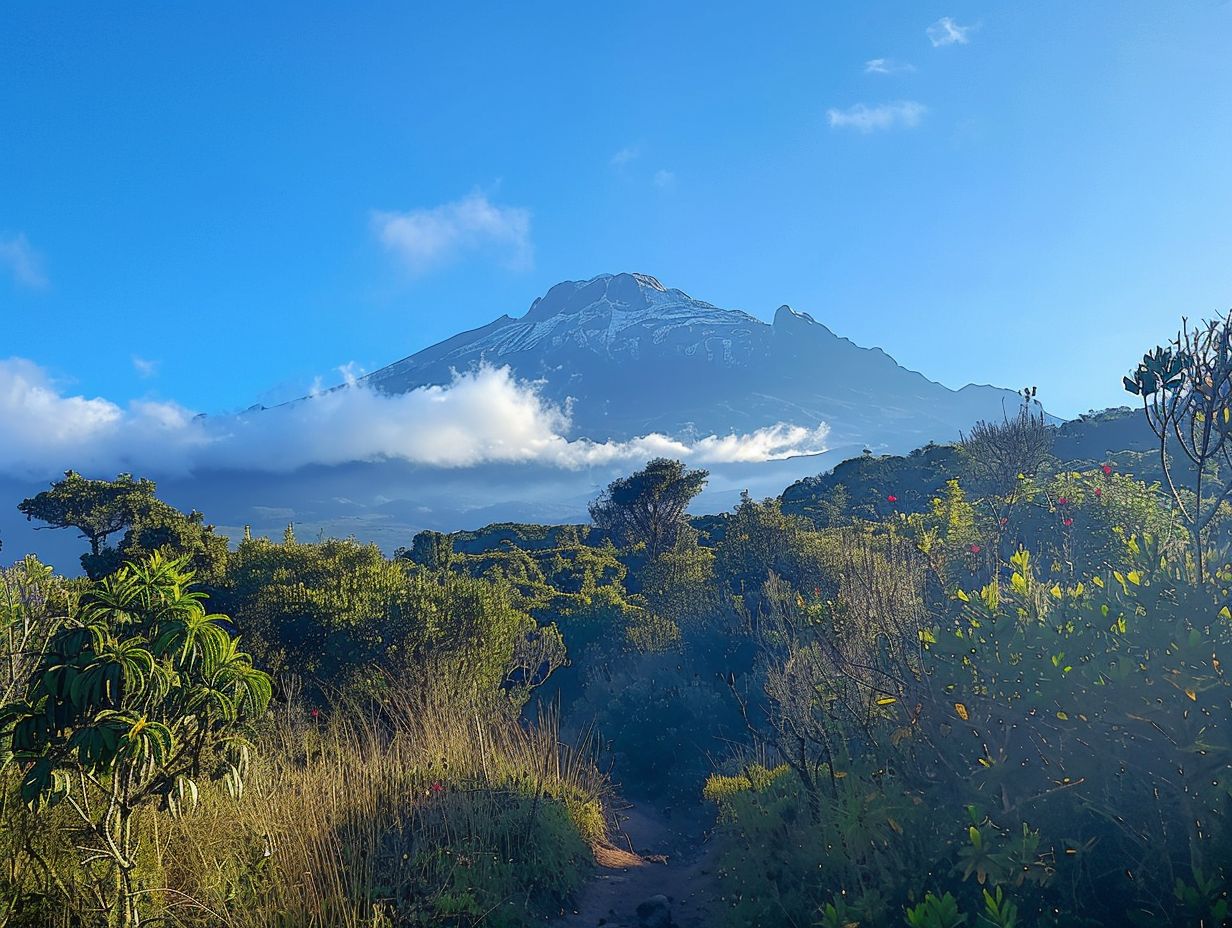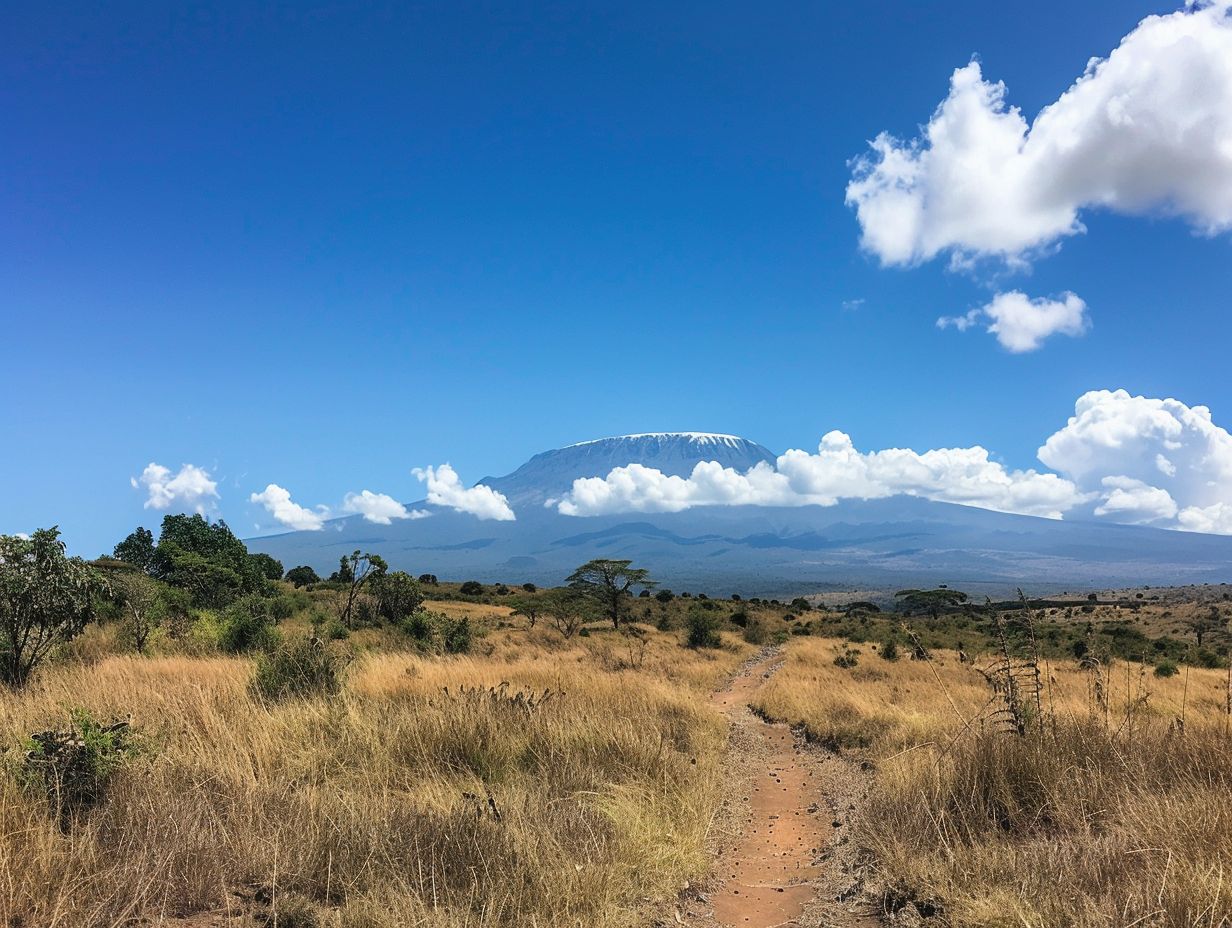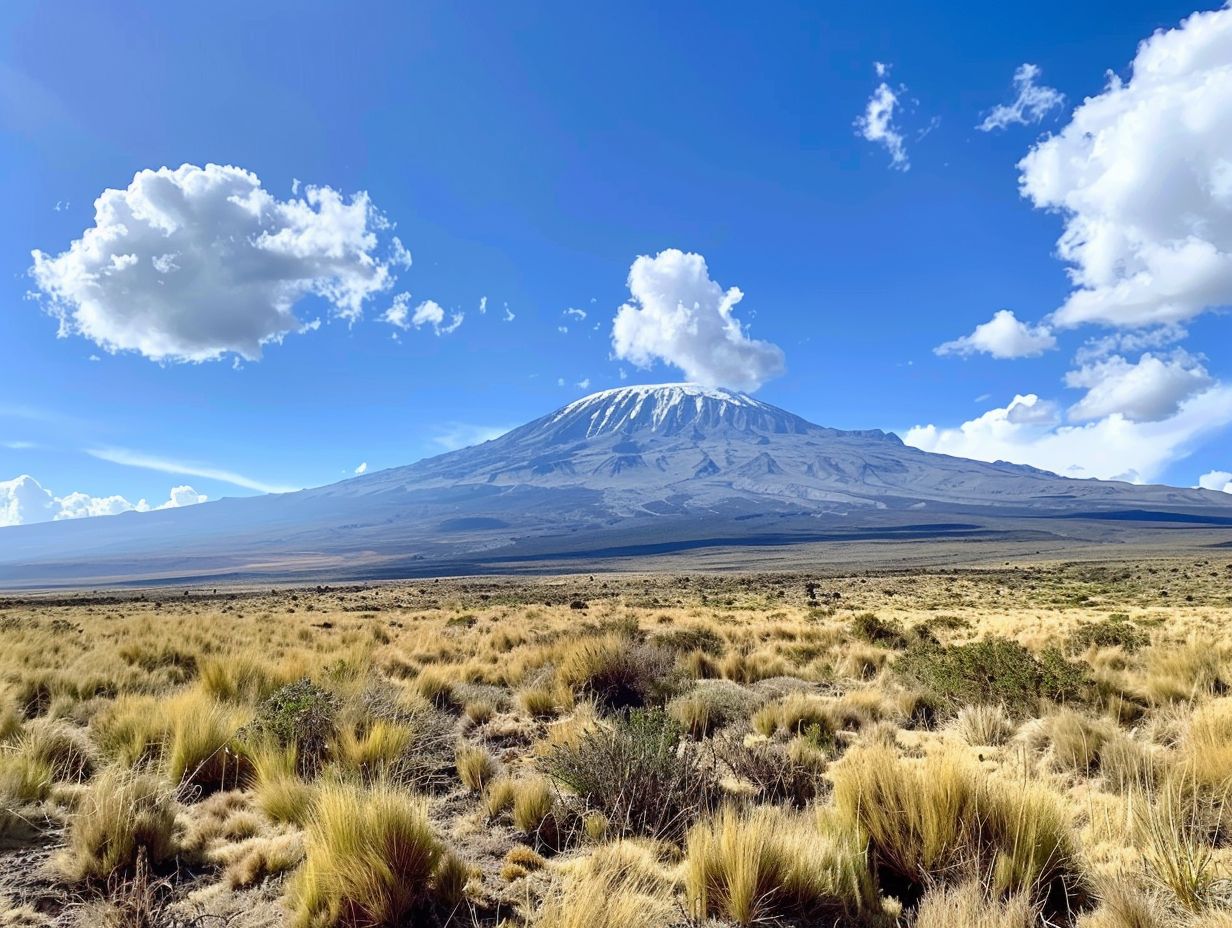
Are you considering climbing Kilimanjaro but unsure of the best time to do so?
In this comprehensive article, we will explore the peak and off-peak seasons for climbing Kilimanjaro, along with the factors to consider when choosing the ideal time for your ascent.
From weather conditions to personal fitness levels, we will cover it all. We will discuss the different routes for climbing Kilimanjaro and the challenges you may face, such as altitude sickness and physical demands.
Stay tuned for tips on how to prepare and ensure a successful climb.
Key Takeaways:

- The best time to climb Kilimanjaro is during the dry seasons of January-March and June-October.
- The peak seasons offer the best weather and availability but come with higher costs and crowds. Off-peak seasons are less crowded and cheaper, but weather conditions may be less favorable.
- When choosing the best time to climb Kilimanjaro, consider weather, crowds, cost, and your own fitness level and preferences.
What is the Best Time to Climb Kilimanjaro?
Determining the best time to climb Kilimanjaro is crucial for a successful expedition. It involves considering various factors such as the weather conditions, visibility, and crowd levels to enhance safety and comfort throughout the trek.
Optimal summit conditions play a significant role in the success of the climb, with climbers aiming for stable weather patterns and clearer skies. During the dry season, typically from late June to early October and late December to mid-February, hikers experience more favorable weather with less rainfall, making it easier to navigate the challenging terrain.
Aligning the climb with the full moon dates allows hikers to leverage the extra light during nighttime ascents, enhancing visibility and creating a magical atmosphere under the luminous glow. Planning the ascent during these peak conditions can elevate the overall experience and increase the chances of reaching the summit.
What are the Peak Seasons for Climbing Kilimanjaro?
The peak seasons for climbing Kilimanjaro typically coincide with the dry months of January, February, July, August, September, and October. During these periods, climbers can expect excellent visibility, manageable temperatures, and safer trekking conditions.
Opting to climb Kilimanjaro during these peak seasons not only enhances the experience but also increases the chances of reaching the summit successfully.
The clear visibility that comes with these months allows trekkers to fully appreciate the breathtaking landscapes and panoramic views from different altitudes. The mild temperatures reduce the risk of extreme weather conditions, making the ascent more comfortable and enjoyable.
One crucial factor to consider when climbing during peak seasons is the condition of the glaciers. The colder months tend to have firmer snow and ice, providing better traction and stability as climbers navigate the challenging terrain.
The well-established routes are likely to be more accessible and less affected by adverse weather conditions, ensuring a smoother and safer journey.
What are the Off-peak Seasons for Climbing Kilimanjaro?
The off-peak seasons for climbing Kilimanjaro are characterized by the rainy months of March and June. Although these periods may present challenges such as reduced visibility and slippery trails, they offer a unique experience for adventurous climbers seeking quieter trails and lush landscapes.
During these off-peak months, climbers need to be well-prepared for the unpredictable weather conditions that come with the rainy season. Heavy rain can make the trails muddy and slippery, adding an extra layer of difficulty to the ascent. For those who are up for the challenge, the lush vegetation that blooms during this time creates a stunning backdrop unlike any other season.
Safety precautions become crucial during off-peak climbing seasons as the weather can change rapidly. It’s essential to pack waterproof gear, sturdy hiking boots, and to be aware of the potential risks of hypothermia due to the cooler temperatures at higher altitudes.
Factors to Consider When Choosing the Best Time to Climb Kilimanjaro
Selecting the optimal time to climb Kilimanjaro involves evaluating critical factors such as weather patterns, temperature variations, trail visibility, crowd levels, safety considerations, and trekking comfort. Understanding the availability of routes and scheduling constraints can contribute to a well-planned and successful ascent.
Weather variations play a significant role in choosing the best time to attempt the Kilimanjaro climb. The dry seasons, typically from June to October and December to March, offer more stable weather conditions, making it favorable for trekking. Conversely, the wet seasons from April to May and November can bring challenges like slippery trails and reduced visibility.
In terms of safety, considering the crowd levels on the mountain is crucial. Opting for less crowded months can not only enhance safety but also allow for a more peaceful and enjoyable experience.
Different routes, such as the Marangu, Machame, Lemosho, or Rongai routes, vary in terms of difficulty, scenery, and traffic. Understanding these route options can help you choose the most suitable one based on your experience and preferences.
Comfort is another vital aspect to contemplate. Being prepared with appropriate gear, adequate acclimatization days, and selecting a time when temperatures are moderate can significantly impact your comfort during the climb. Having scheduling flexibility can be advantageous, as it allows you to adjust your plans based on weather forecasts or personal circumstances.
Weather and Temperature
Understanding the weather and temperature conditions on Kilimanjaro is essential for planning a successful climb. The mountain features diverse climate zones that can impact trekking conditions, safety protocols, and overall comfort levels, especially during significant lunar phases like the New Moon.
At lower altitudes, climbers may encounter a mild, equatorial climate characterized by warm temperatures and high humidity. As one ascends, the weather can change dramatically, transitioning to chillier conditions with the risk of sudden temperature drops and strong winds.
This variability necessitates appropriate layering of clothing and gear to ensure protection against the elements and prevent hypothermia. It is crucial to monitor weather forecasts closely and be prepared for sudden shifts in conditions, taking into account the effects of altitude on temperature and visibility.
The influence of lunar phases, particularly the New Moon, can significantly impact visibility during nighttime treks. The absence of moonlight may pose challenges in navigation, making it essential to carry sufficient lighting equipment and adhere to safety precautions to minimize the risk of getting lost.
Trekking guides often adjust schedules and routes accordingly during these phases to ensure optimal safety and visibility for climbers, emphasizing the importance of planning climbs around lunar cycles for enhanced security and successful summit attempts.
Crowds and Availability

Considering the crowds and availability of facilities is crucial when planning a Kilimanjaro climb.
Managing overcrowded trails on Kilimanjaro can detract from the overall experience and even pose safety risks for climbers. To cope with trail congestion, trekkers can opt for less busy routes or start their ascent during off-peak seasons. Arranging alternative campsite options beforehand can help ensure a comfortable resting place during the journey.
Cost and Budget
Evaluating the costs and budget considerations for a Kilimanjaro climb is essential for effective trip planning. Understanding the pricing structures of different routes, accommodation options, and additional expenses can help climbers make informed financial decisions and ensure a well-budgeted expedition.
When planning a Kilimanjaro climb, it’s important to note that the costs can vary significantly based on various factors. Route selection plays a crucial role, with some routes being more expensive due to their popularity or amenities. The choice of accommodation can impact the overall cost, as luxury lodges will come with a higher price tag compared to basic camping arrangements.
Personal Preferences and Fitness Level
Considering personal preferences and fitness levels is paramount when planning a Kilimanjaro climb. Tailoring the expedition to individual fitness capabilities, undergoing necessary training programs, and prioritizing safety and comfort can significantly enhance the overall trekking experience.
It is essential to assess the level of physical fitness before embarking on a Kilimanjaro expedition.
Engaging in a consistent training regime focusing on cardiovascular endurance, strength, and stamina is crucial to prepare the body for the challenges ahead.
Investing in proper gear and equipment that provide both safety and comfort, such as sturdy hiking boots, appropriate clothing layers, and a reliable backpack, ensures a smoother trekking journey.
Adapting the climbing itinerary to match personal preferences and pace can make the ascent more enjoyable and manageable, allowing climbers to savor every moment of this extraordinary experience.
What are the Different Routes for Climbing Kilimanjaro?
Kilimanjaro offers various routes for climbers to choose from, each presenting unique challenges and scenic views. Popular routes like the Lemosho Route leading to Kosovo Camp are favored for their safety features and experienced guides, ensuring trekkers can navigate the mountain with confidence.
One of the standout features of the Lemosho Route is its gradual ascent, allowing climbers ample time to acclimatize to the altitude while soaking in the breathtaking landscapes. The Kosovo Camp, nestled along this route, serves as a tranquil resting point for adventurers, offering stunning views of the surrounding terrain.
When considering guide services for a Kilimanjaro expedition, reputable companies provide knowledgeable guides who are well-versed in the terrain and equipped to handle any challenges that may arise. Safety considerations, such as proper acclimatization, hydration, and emergency protocols, are paramount when embarking on this adventure to ensure a successful and secure climb.
What are the Challenges of Climbing Kilimanjaro?
Climbing Kilimanjaro presents adventurers with a series of challenges that test their physical and mental endurance.
One of the primary obstacles climbers face is the risk of altitude sickness, which becomes more prevalent as they ascend to higher altitudes. The lack of oxygen at such heights can lead to symptoms like headaches, nausea, and fatigue, requiring climbers to acclimatize properly to minimize the effects.
Along with altitude sickness, the physical demands of the climb can be strenuous, with long hours of hiking through varied terrain testing the endurance of even the most seasoned climbers.
Altitude Sickness
Altitude sickness is a prevalent concern among climbers ascending Kilimanjaro due to the rapid altitude gain. Implementing a structured acclimatization program, following safety guidelines, and monitoring summit success rates are crucial in mitigating the risks associated with high altitudes.
Several factors contribute to the likelihood of altitude sickness during Kilimanjaro ascents. Dehydration and lack of proper rest can exacerbate symptoms, impacting the climber’s overall experience and safety.
It is imperative for climbers to pace themselves and acclimate gradually to the increasing elevations on the mountain. Proper hydration, adequate nutrition, and listening to the body’s signals are essential for a successful climb without compromising health.
Physical Demands

The physical demands of climbing Kilimanjaro require trekkers to possess adequate fitness levels and mental resilience.
Navigating this majestic peak involves traversing through diverse landscapes, from lush rainforests to rugged alpine deserts, each presenting its own set of challenges. Trekkers must acclimate to changing altitudes and weather conditions, pushing their bodies to adapt swiftly.
Success on Kilimanjaro hinges on meticulous preparation, including endurance training, proper gear selection, and developing a positive mindset for overcoming obstacles along the way. Climbers often face steep ascents, rocky paths, and chilly winds, requiring a blend of physical strength and unwavering determination.
Weather Conditions
Navigating the diverse weather conditions on Kilimanjaro is a critical aspect of expedition planning. From encountering rain and snow to grappling with foggy conditions that affect visibility, climbers must be prepared for the ever-changing climate on the mountain.
Heavy rain can turn trails into slippery mudslides, making progress slow and challenging. Similarly, snowstorms not only decrease visibility but also add a layer of difficulty to the climb, requiring extra caution and endurance from climbers.
Thick fog on Kilimanjaro can be disorienting, increasing the risk of losing track of the route and fellow climbers. To combat these weather challenges, experienced guides often advise using proper gear such as waterproof clothing and boots, as well as continuously monitoring weather forecasts to adjust plans accordingly.
How to Prepare for Climbing Kilimanjaro?
Effective preparation is key before embarking on a Kilimanjaro climb, involving physical training, acquiring appropriate gear, and understanding essential safety precautions.
From selecting the right trekking equipment to preparing for wet-weather conditions and preventing hypothermia, climbers must equip themselves thoroughly for the challenging journey ahead.
Training regimes play a crucial role in building stamina and endurance for the demanding terrain. Consistent cardio exercises, strength training, and hiking with a fully loaded backpack can help in acclimatizing to the altitude.
Ensuring you have the essential gear for the climb is imperative. From sturdy hiking boots to layers of clothing for variable weather, packing strategically can make a significant difference in comfort and safety during the expedition. Quick-dry clothing, waterproof jackets, insulated gloves, and a reliable headlamp are all essential items.
In wet-weather conditions, having the right gear can be a game-changer. A sturdy rain cover for your backpack, waterproof pants, and gaiters can help keep you dry and warm even in heavy rain. Packing extra dry layers and keeping essentials in waterproof bags can prevent hypothermia risks.
To combat the dangers of hypothermia on the mountain, staying warm and dry is crucial. Ensuring proper layering, keeping spare dry clothes, using insulation pads under tents, and having access to warm drinks can help maintain body temperature. Understanding the signs of hypothermia and taking preventive measures is vital for a safe and successful climb.
Tips for a Successful Climb
Achieving a successful climb on Kilimanjaro requires strategic planning and adherence to essential tips that enhance trekking experiences. From optimizing trekking schedules for peak visibility to leveraging top tips for summit success and indulging in mesmerizing star-gazing moments, climbers can elevate their journey to the summit.
When planning your climb, it is crucial to consider the best time of the year to maximize your chances of clear skies and breathtaking views. Typically, the best months to climb Kilimanjaro are during the dry seasons, which are from June to October and from December to February.
These periods offer a higher chance of good weather, making your trek more enjoyable and increasing visibility of the surrounding landscapes.
Along with scheduling your climb wisely, it’s essential to stay well-hydrated and properly acclimatize to the altitude to avoid altitude sickness. Packing essential items like waterproof gear, warm clothing layers, and high-energy snacks can make a significant difference in your comfort and success on the mountain.
As you ascend towards the summit, remember to pace yourself and listen to your body. Slow and steady progress allows for better acclimatization and reduces the risk of altitude-related issues. Embracing the local saying, ‘pole pole,’ which means ‘slowly, slowly,’ can be instrumental in reaching the summit safely.
Conclusion
Conquering Kilimanjaro is a remarkable feat that encompasses challenges, triumphs, and unforgettable moments. From summiting the majestic peak to marveling at its pristine glaciers, every climber’s journey is a testament to resilience, perseverance, and the commitment to safety throughout the expedition.
Summiting Kilimanjaro is not just reaching the highest point of Africa but also diving into a world where jagged glaciers meet the equatorial air. The glaciers, like remnants of the last ice age, are a breathtaking sight that contrasts with the surrounding African landscape.
As climbers navigate through their ascent, they witness the raw beauty of these ice formations, reinforcing the fragile balance between nature’s grandeur and human endeavor. Safety measures play a paramount role in this climb, with experienced guides, proper gear, and altitude acclimatization crucial in ensuring a successful and secure expedition.
Frequently Asked Questions
When is the best time to climb Kilimanjaro?

The best time to climb Kilimanjaro is during the dry season, which is from July to October. This is when the weather is most stable and there is less chance of encountering rain or snow.
Can you climb Kilimanjaro year-round?
Yes, you can climb Kilimanjaro year-round. However, it is not recommended to climb during the rainy season, which is from March to May. The trails can be slippery and the weather can be unpredictable, making it more challenging and dangerous.
Are there any advantages to climbing Kilimanjaro during the off-season?
Yes, there are some advantages to climbing Kilimanjaro during the off-season. The trails are less crowded, making for a more peaceful and solitary experience. Additionally, the prices for permits and accommodations may be lower during this time.
What is the weather like on Kilimanjaro?
The weather on Kilimanjaro can vary greatly depending on the time of year and elevation. Generally, the temperature gets colder as you ascend, and it can range from hot and humid at the base to below freezing at the summit. It is important to pack appropriate clothing and gear for all types of weather.
What is the success rate for climbing Kilimanjaro?
The average success rate for climbing Kilimanjaro is around 65%. However, this can vary depending on factors such as the route chosen, the weather conditions, and the physical fitness of the climbers. Choosing a reputable and experienced guide can greatly increase your chances of success.
Is it possible to climb Kilimanjaro without any prior experience?
While it is technically possible to climb Kilimanjaro without any prior experience, it is highly recommended to have some hiking and camping experience. The trek can be physically and mentally demanding, and having some experience with long hikes and camping can greatly increase your chances of success.